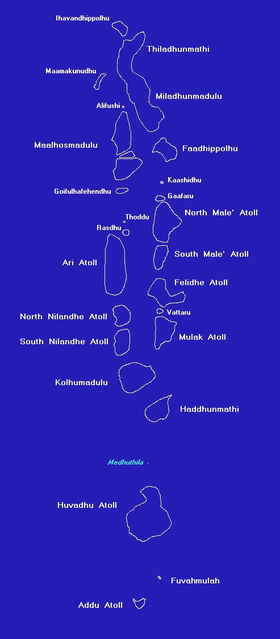
Back آتولات جزر المالديف Arabic Atolle der Malediven German ދިވެހިރާއްޖޭގެ އަތޮޅުތައް DV Liste des atolls des Maldives French માલદિવ્સ ના ટાપુઓ Gujarati モルディブ諸島 Japanese Atollen van de Malediven Dutch Zoznam atolov na Maldivách Slovak
This article needs additional citations for verification. (March 2008) |



The Maldives are formed by 20 natural atolls, along with a few islands and isolated reefs today which form a pattern stretching from 7 degrees 10′ North to 0 degrees 45′ South. The largest of these atolls is Boduthiladhunmathi, while the atoll containing the most islands is Huvadhu.
Some atolls are in the form of a number of islands by time and in the form of isolated reefs, which could be classified as smaller atoll formations. All land above the surface in the Maldives is of coralline origin. The atolls of the Maldives form a quite regular chain and, especially in the northern and central atolls, an arrayed structure is apparent. There are broad and deep channels between some atolls.[1] The origin of the word "atoll" itself is in the language of the Maldives. "Atoll" (from Dhivehi: atholhu) is now used in many languages worldwide.[2]
Traditionally, Maldivians call the atolls ending in '-madulu' or '-mathi' by their name without adding the word "Atoll" at the end. For example, it is correct to write simply Kolhumadulhu, without adding the word 'Atholhu' at the end. This is also the case in the atoll known as Faadhippolhu.
The atolls of the Maldives are very complex structures and were formerly very dangerous for navigators. In 1834–1836, British captain Robert Moresby undertook the laborious and difficult cartography of the Maldives, drawing the first accurate maritime charts of this complicated Indian Ocean atoll group.
These Admiralty charts were printed as three separate large maps by the Hydrographic Service of the Royal Navy. Although they contain a few errors, Moresby's charts were so good that they were favoured by Maldivian pilots navigating through the treacherous waters of their atolls until the 1990s.
Nowadays there are more accurate maps of the Maldives based on satellite surveys. However, Maldivian navigators still claim that Captain Moresby's charts provide a wealth of data that the modern maps do not give. At the time that they were drawn, the maps of the Maldives were deemed of such high quality that they were inspected personally by Queen Victoria.[3] Even today in some atolls, the modern day marine GPS can be inaccurate. The GPS mapping may indicate reef where it does not exist and does not show other reefs where they are located.
Owing to the many beautiful diving grounds of the numerous atolls of the Maldives, this country has been marketed as a prime destination for scuba divers worldwide. Hence, during the last couple of decades many guides and maps of the best diving spots have been published and some of them are very accurate and give a wide array of useful hints.
- ^ H.C.P. Bell, The Maldive Islands, An account of the physical features, History, Inhabitants, Productions and Trade. Colombo
- ^ Bell, H. C. P. (1989) [1940]. The Maldive Islands: Monograph on the History, Archaeology and Epigraphy. Malé, Maldives: Novelty Printers & Publishers. ISBN 9789991530512. OCLC 314449970.
- ^ Searight, Sarah, The Charting of the Red Sea, History Today, 2003
© MMXXIII Rich X Search. We shall prevail. All rights reserved. Rich X Search